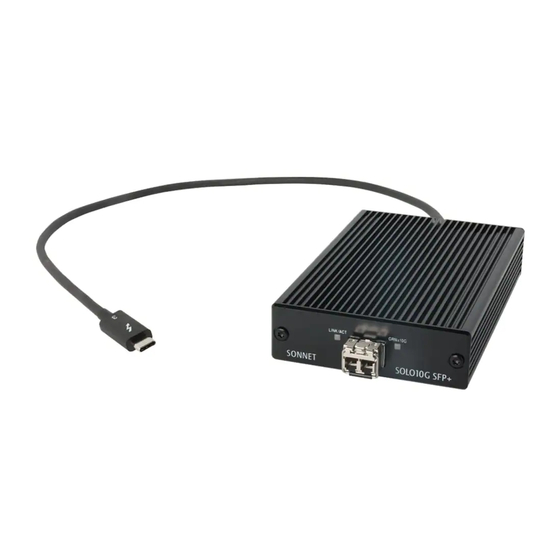Table of Contents
Advertisement
Quick Links
10
Solo
G
SFP+ Thunderbolt
™
10 Gigabit Ethernet to Thunderbolt 3 Adapter
with 10GBASE-SR (Short-range) SFP+ Transceiver
Quick Start Guide
Solo10G SFP+ Thunderbolt 3 Edition (T3E) Description
1 – SFP+ Socket
Insert the included short-range SFP+ optical transceiver into the
socket, making sure it is firmly seated and secured. Alternatively,
you can install a long-range SFP+ transceiver or an RJ45 SFP+
copper transceiver (both sold separately). You may even use a
direct-attached SFP+ terminated copper cable up to 10 meters
long (sold separately) to connect to a switch or storage system.
2 – Link/Activity Indicator
This LED lights up green to indicate a link is established between
the adapter and the switch, and flashes yellow when the link is
training.
3 – Link Speed Indicator
When a link is established between the adapter and the switch,
this LED lights to indicate the link speed to the switch: green =
10Gb, yellow = lower speeds.
3
Edition
You Should Have
™
The following items should be included in your product package:
• One Solo10G SFP+ Thunderbolt 3 Edition (T3E) adapter
• 10GBASE-SR (short-range) SFP+ transceiver
• QSG
Mac® Compatibility
• Mac with Thunderbolt 3 ports
• macOS
• macOS Mojave compatible
Windows® Compatibility
• PC with Thunderbolt 3 ports
• 64-bit editions of Windows
or later
Important Note: Windows computers require the latest BIOS and
Thunderbolt drivers to support this product. Check with your
computer manufacturer for update information.
may have occurred since then. Please check the Sonnet website for
the latest documentation.
Thunderbolt 3 Connector—Plug this connector into one of your
computer's Thunderbolt 3 ports (often indicated by a logo), or at the
end of a Thunderbolt device chain. Ports marked with the USB icon
(
Driver Information
For Mac users, the drivers required to support the Solo10G SFP+ T3E
are installed as part of macOS 10.13.6 and later; the Sonnet adapter is
ready for use when you power on your computer.
For Windows users, please go to www.sonnettech.com/support/
kb/kb.php, and then click the Thunderbolt link. Locate and click
Solo10G SFP+ Thunderbolt 3 Edition link, and then click the Driver
link. Locate, download, and install the appropriate drivers.
First Time Use—Windows
The first time you connect the Solo10G adapter to your computer,
an Approve New Thunderbolt™ Devices window will appear. From the
drop-down menu select Always Connect, and then click OK.
®
10.13.6+
10, Version 1709 (Creator's Edition),
®
Support Note:
This document was up to date at the time of
printing. However, changes to the hardware or software
1. Go to www.sonnettech.com/support/kb/kb.php
2. Click the Thunderbolt link.
3. Locate and click Solo10G SFP+ Thunderbolt 3 Edition link, and
then click the Documentation link.
4. Click the Solo10G SFP+ Thunderbolt 3 Edition Quick Start Guide
[English] link, and then check the Document Version information.
If the version listed is later than this document (revision A), click
the Download Now button for the latest version.
) are NOT compatible.
Advertisement
Table of Contents

Summary of Contents for Sonnet Solo10G SFP+ Thunderbolt 3 Edition
- Page 1 For Mac users, the drivers required to support the Solo10G SFP+ T3E you can install a long-range SFP+ transceiver or an RJ45 SFP+ are installed as part of macOS 10.13.6 and later; the Sonnet adapter is copper transceiver (both sold separately). You may even use a ready for use when you power on your computer.
- Page 2 ©2018 Sonnet Technologies, Inc. All rights reserved. Sonnet, the Sonnet logotype, Simply Fast, the Simply Fast logotype, and Solo10G are trademarks of Sonnet Technologies, Inc. Mac, the Mac logo, and macOS are trademarks of Apple Inc., registered in the United States and other countries.
















Need help?
Do you have a question about the Solo10G SFP+ Thunderbolt 3 Edition and is the answer not in the manual?
Questions and answers